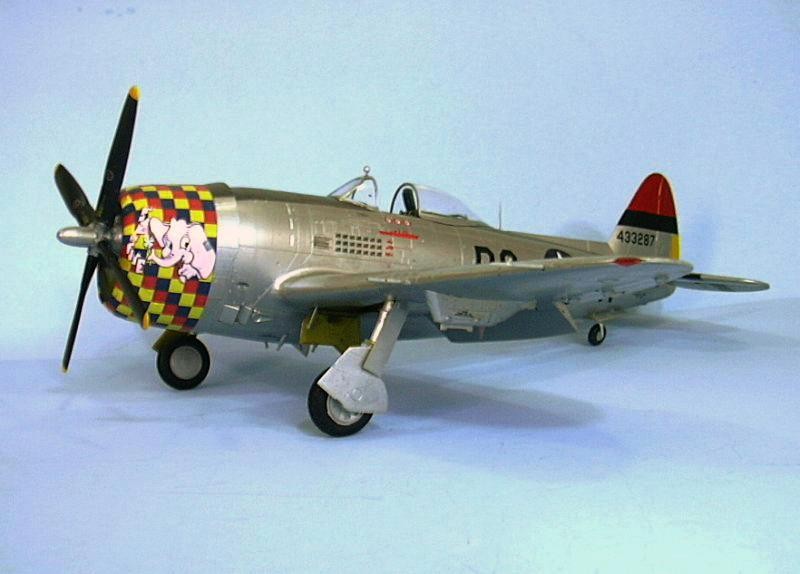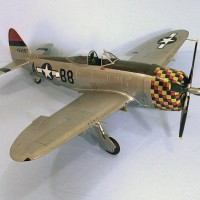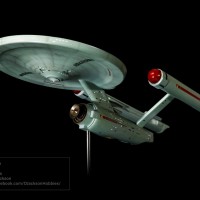Trumpeter 1/32 P-47D-30 Thunderbolt
Col. Joe Laughlin and the 362nd Fighter Group:
Joseph L. Laughlin joined the USAAC in 1939 and received his wings and commission in June 1940, and was assigned to the 14th Pursuit Squadron at Wheeler Field, Hawaii that September.
Following the attack on Pearl Harbor, Laughlin flew a 350-hour combat tour against the Japanese in the Central Pacific, ending his tour as CO, 45th FS, 18th FG. He returned to the US in the fall of 19433 and took command of the newly-formed 379th FS, 362nd FG.
Known as "Mogin's Maulers" in tribute to their commander Col. "Mogin" Magoffin, the 362nd FG arrived in England at the end of November 1943. They received their first P-47 Thunderbolts on December 29, 1943. Once fully operational in mid-February 1944, the 362nd FG began flying escort missions with the 8th Air Force during the latter stages of the action known as “Big Week.” , the Group cut its combat teeth escorting bombers of the Eighth Air Force on their missions over the Continent.
The 362nd FG was awarded their first of two Distinguished Unit Citations (DUC) for action on August 25, 1944 when they attacked targets in Brest harbor, in which direct hits were scored on two cruisers, one of which was left beached and burning. Col. Laughlin - who had just assumed command of the group following the loss of Col. Magoffin to flak on August 19 - gained the distinction of being the only USAAF fighter pilot in the ETO to be credited with having sunk a capital German warship. Additionally, 12 naval and merchant vessels engaged in troop evacuation were damaged severely. Although the primary assignment of the 362nd FG was close air support, they were credited with shooting down 137 German aircraft. Their work over the Continent following the invasion cost 97 pilots killed or captured.
The 362nd FG was fortunate to have among its assigned pilots one George Rarey, called "Dad" by the other pilots due to his having reached the advanced age of 25 when he joined the USAAF in 1942. A successful commercial artist before the war, Rarey was responsible for the group's nose-art from their arrival in England in November 1943 until his death in combat in June 1944.
Following Rarey's death, his role as Group Artist was undertaken by his former crew chief, who maintained Rarey's distinctive style. P-47D-30-RA, 44-33287, was the last of 12 P-47s flown by Colonel Laughlin, all named "Five-by-Five," and all carrying Rarey's distinctive painting of a pink elephant.
This late-model P-47D-30 is the fourth, and last, of Trumpeter's 1/32 Thunderbolts. It differs primarily from the first bubble-top kit in having a separate vertical fin part that includes the dorsal fin extension that is the primary visual difference between the early and late-production Thunderbolts. Otherwise, this kit is the same as the earlier one.
Unfortunately, the kit provides only the corrugated cockpit floor appropriate to the P-47D-25. A modeler for whom this is a real sticking point could replace the cockpit floor with a scratchbuilt floor done with Evergreen sheet.
The kit provides decals for two aircraft, including “Five-by-Five,” in her final markings. Unfortunately, Trumpeter continues to have difficulty reproducing the U.S. National Insignia in its proper dimensions, so a modeler must obtain suitable aftermarket decals to take care of these.
Regarding construction of Trumpeter P-47s, I have found that if you are going to close the weapon doors in the upper wing, it is best to put a sheet of Evergreen inside before further assembly, to keep the doors up on their proper position, otherwise they will settle lower than the wing surface. Also, it is completely unnecessary to install all the extensive tubo ducting. You will never see it, and it makes the fuselage hard to close up.
Having run out of Talon acrylic metalizer paints, and being unwilling to risk a violent death by spraying Alclad inside (it being somewhat chilly out when I built this) I looked for another acrylic metalizer. The paint expert at the local artists supply store pointed me toward Auto-Air, which comes in a bottle about three times the size of an Alclad bottle, for half the price, and produces a finish that looks just like Alclad Duraluminum. You thin it 50-50 with water, and it works like a champ. It needs a coat of primer to grab onto however. I found that applying a thin coat of Tamiya Flat Aluminum provided the perfect primer, since it only took a few passes with the Auto-Air paint to get a good finish. The paint is still fragile, however. I found putting a coat of Model Master Metalizer Sealer on did the trick - and the Auto-air paint did not lose its luster the way Model Master Metalizer does when it is sealed. I still find that it's a good idea to handle the completed model by any part that is not painted silver, since you can wear the paint away from leading/trailing edges and such.
I used national insignia from a Cutting Edge/Meteor sheet, and the kit decals. I think the red and blue checks aren't the right shade, but I wasn't interested in trying to mask that scheme and paint it.
Now that Hasegawa's prices are so high, there isn't that much price difference between Hasegawa and Trumpeter. Trumpeter provides every drop tank and all the ordnance a P-47 ever carried, as well as all three props, which Hasegawa doesn't.














A VERY NICE Jug Tom. She really is impressive. I like the colorful cowling. Well done!
love it
I've built a couple of these - the 'N' comes to mind particularly - some people don't care for the vinyl tyres but I don't mind them really.
Nicely presented.
Maybe it's the Alclad making you see pink elephants? Ha ha. Nice T-Bolt.
Nice Jug, Tom. Thanks for the info on the paint. I'm always looking for new ways to do NMF.
Another Cleaver classic done to perfection. My only niggle and it doesn't have to do with the modeler...Trumpeter skimped on the wheel/tire arrangement. Look mom,no brakes. It would be great if there was a resin replacement for the tire/wheels. Given the price of the kit one, would expect that the foundation that holds the kit up would be equal to the task. Or reflect the rest of the kits finer points.
Great build, Tom. Love that metallic sheen. As always I enjoy being enlightened with the history behind the model.
Looks great Tom! Certainly a level of skill for me to work toward. Enjoyed the historical background and the paint info. Would be interesting to see if it is carried in Canada.
Another great build Tom. Love the markings and this kit. Good tip about leaving the turbo ducting out, saves so much time and aggravation!
The only thing I don't like about this kit is that the complete model is too heavy for the tailwheel and bends it. Otherwise great kit with lots of options and ordanance!
Stephen, Barracuda do a set of great resin main wheels for this kit in various tread patterns. They didn't do the tailwheel in resin unfortunately.
Nice big Jug Tom.
As ever a brief history lesson and fine build .
Well done mate.
Sorry for beeing a bit late to the Jug - Party :-). Great history with a very nice P-47. German cruisers in Brest, August 1944 ?
At this point all german capital ships were sunk, deployed it the baltic and one in Norway.
Tom,
Great build love the scheme.